Physical Address
304 North Cardinal St.
Dorchester Center, MA 02124
Epithelial wrinkling is a severe ocular complication of contact lens wear and is characterised by the appearance of a series of deep parallel grooves in the corneal surface, giving the impression of a ‘wrinkled’ effect ( Fig. 21.1 ). This condition was originally described as ‘epithelial folds’ by Quinn and was later described more fully by Lowe and Brennan, who coined the term ‘corneal wrinkling’. Epstein referred to this condition as ‘epithelial wrinkling’.
As will be discussed in the ‘Pathology’ section later, there is a difference of opinion in the literature as to the depth of the wrinkles in the cornea. Specifically, it is unclear whether the phenomenon occurs purely at the level of the epithelium or whether there is also some stromal involvement. Since two of the previously mentioned authors adopted a name for this condition that implies primarily epithelial involvement and two adopted the word ‘wrinkling’, the term ‘epithelial wrinkling’ is used in this book. It follows, therefore, that this condition is discussed in this section on ‘Corneal epithelium’.
Epstein deemed epithelial wrinkling to be ‘a very rare complication of soft lens wear’. However, in a prospective clinical trial of 330 subjects wearing disposable hydrogel lenses on a six-night extended-wear and replacement schedule, Sankaridurg et al. found a prevalence of 1.7 events of ‘corneal wrinkling’ per year of lens wear and that the condition eventually resolved without sequelae. It is unclear whether Sankaridurg et al. were observing true epithelial wrinkling, as characterised in this chapter, or an unrelated form of pathology, such as oedematous folds in the deeper corneal layers.
There have apparently been no reports of contact lens–associated epithelial wrinkling since the early 2000s; however, it is possible to induce wrinkling if inappropriate parameters are chosen for the design of custom-made hydrogel lens, as explained later. It is, therefore, still pertinent to present an account of this condition to avoid such occurrences in the future and to assist practitioners in identifying this condition in the unlikely event that they come across corneal wrinkling in the future.
The case described by Lowe and Brennan took the form of two linear wave patterns of fluorescein pooling across the central cornea and intersecting at an angle of 70° ( Fig. 21.2 ). Several discrete spots were observed at the points of intersection of the two wave patterns. The intensity of fluorescein within the troughs of the wrinkles was observed to increase with time after a blink. The patient was wearing a very thin (0.036 mm centre thickness) mid-water-content (52.5% water) custom-designed hydrogel lens in one eye. The lens was said to be made of a highly elastic material (‘Snoflex 50; Smith & Nephew, Australia), with a power of − 0.50 diopter (D) and a back optic zone radius of 8.20 mm. The patient had a keratometer reading of 8.00/7.92 mm; thus, the lens was fitted very steep in relation to the cornea.
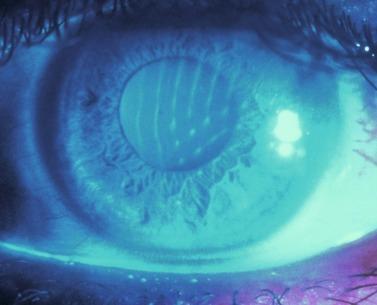
Lowe and Brennan assessed the extent of corneal distortion by observing the reflected mires of an optical keratoscope. The formation of ridges and troughs can clearly be seen to mimic the observed fluorescein pattern ( Fig. 21.3 ).
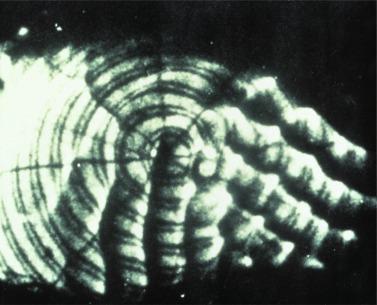
Burnett-Hodd reported the case of a patient wearing a very thin, custom-designed hydrogel toric lens. The lenses had a back optic zone radius of 7.40 mm, and the patient had a mean keratometer reading of 7.80 mm. The reason for fitting this lens very steep in relation to the cornea was to stop the rotation of the lens which had occurred with flatter designs. These lenses displayed profound wrinkling during wear; this effect can be seen for one eye in Figure 21.4 . When this lens was removed and fluorescein instilled, a series of linear wrinkles could be observed both in white light ( Fig. 21.5 ) and in cobalt blue light ( Fig. 21.6 ), corresponding to the previously observed wrinkling of the lens.
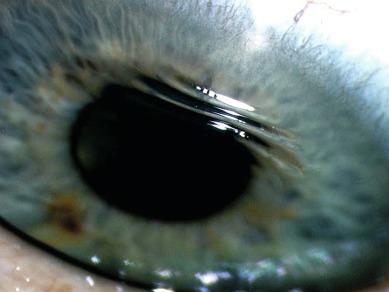
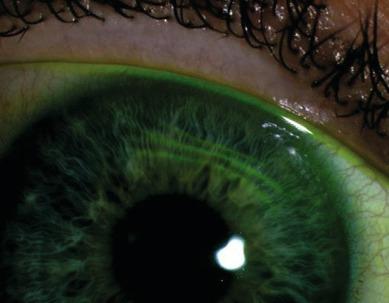
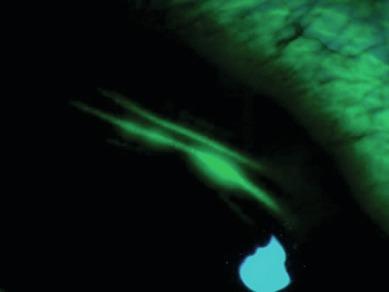
Wrinkles can occur in any orientation or, indeed, in multiple orientations in the one eye. In the case reported by Burnett-Hodd ( Fig. 21.6 ), the wrinkles were at an angle of about 160° (ophthalmic lens axis notation). In another case, shown in Figure 21.7 , the wrinkles were at an angle of about 80°. The wrinkles ran in different directions in the same eye in the case depicted in Figures 21.1 and 21.2 .
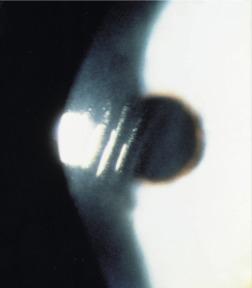
Giese described a 17-year-old patient who had Marfan’s syndrome and developed central epithelial wrinkling in his right eye while he was wearing low-water-content hydrogel lenses. No visual discomfort or distortions were noted. The patient was refitted with a non–hydroxyethyl methacrylate hydrogel contact lens, with no further episodes of wrinkling observed during subsequent care of the patient. Although Giese expressed the view that the wrinkling was unrelated to Marfan’s syndrome, there may be a link because Marfan’s syndrome is primarily a heritable connective tissue disorder. Bowman’s layer, which is composed almost entirely of collagen (a connective tissue), is implicated in the appearance of wave-like patterns that mimic contact lens–induced epithelial wrinkling (see ‘Differential diagnosis’ ). Therefore the corneas of patients with Marfan’s syndrome may well be prone to developing wrinkle-like patterns when the cornea is subjected to physical stresses of contact lens wear.
Become a Clinical Tree membership for Full access and enjoy Unlimited articles
If you are a member. Log in here